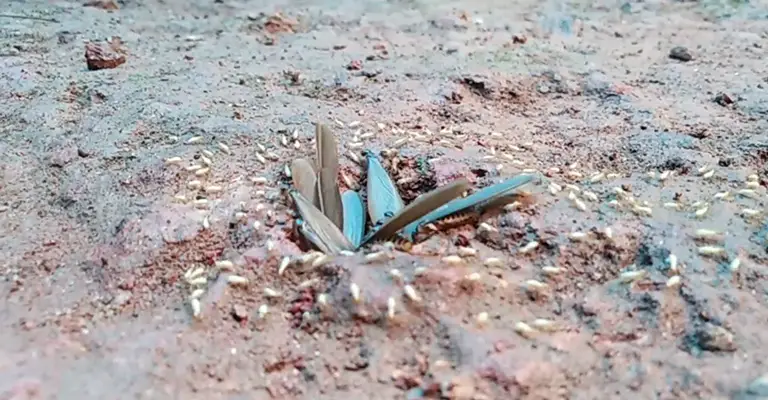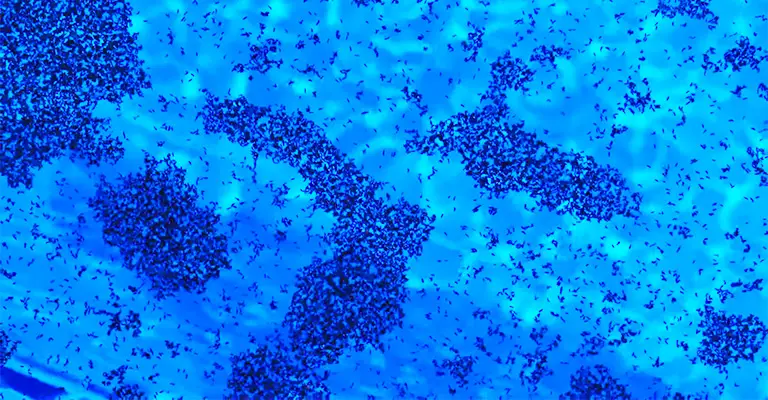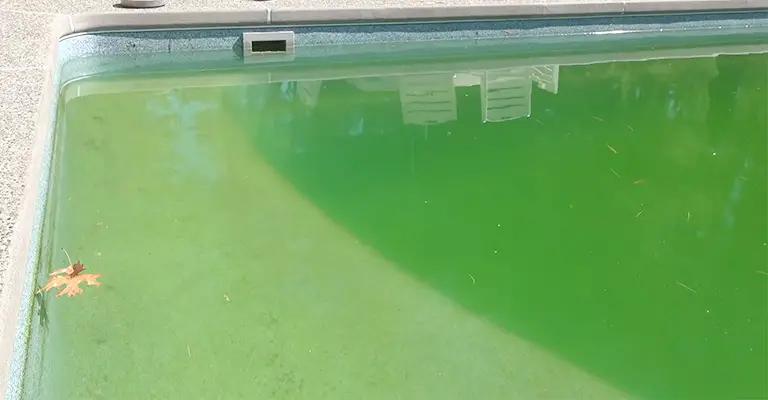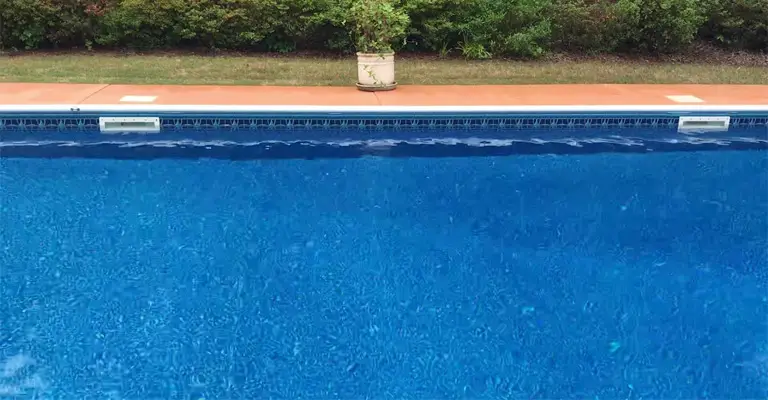Have you ever noticed tiny termites floating in your pool after a rainy day? It might seem strange, but there’s a reason behind this puzzling phenomenon.
Flying termites are not uncommon during the spring after a rain. Alates (also called swarmers) emerge normally from tree stumps, cracks in foundations, or even the ground.
Termites are attracted to swimming pools because they provide a source of moisture, food, and shelter.
They can also get inside pool filtration systems, where they can reproduce and cause further damage.
Regularly inspecting the pool and repairing any cracks or leaks can help reduce the number of termites.
In rare instances, thousands of termite offspring can be found in one colony. The termites are responsible for leaving the nest, seeking a mate and establishing the colony.
Is It Normal To See Termites After Rain?
Termites in pools after rain can be a perplexing sight for many homeowners. The correlation between rainy weather and the presence of termites in your pool is not coincidental.
Termites are attracted to moisture, and heavy rainfall can create an environment conducive to their survival and migration.
During a downpour, termite colonies often become inundated with water, forcing the pests to search for drier ground.
Consequently, they might inadvertently end up in nearby pools, mistaking them for a safe haven.
Additionally, termites are known to be drawn to sources of water, and pools, with their abundant moisture, can appear to be an appealing location for these moisture-seeking insects.
Moreover, the structural components of pools, such as the wooden frames or decking, can also attract termites due to their cellulose content, which serves as a primary food source for these wood-destroying pests.
Therefore, the combination of moisture and potential food sources can lead termites to infest pool areas, especially after a period of heavy rainfall.
To prevent the recurrence of such incidents, it is crucial to implement effective termite control measures and regularly inspect your property for any signs of termite activity, especially during the rainy season.
Taking proactive steps to maintain the structural integrity of your pool and addressing any potential vulnerabilities can help mitigate the risk of termite infestations and preserve the condition of your property.
Why Are There So Many Termites In My Pool?

Termites behave differently when it rains because the environment’s temperature and moisture levels change. It is necessary for termites to establish new colonies in certain conditions in order to survive.
There is a tendency for increased rainfall to give termites a better environment to thrive in – and that may be a problem for homeowners who discover termites working within their walls.
Swarms are formed during the late winter months when the queen sends signals that allow termites to develop into reproductive stage termites before conditions are favorable for their survival.
Termites swarm when spring rains and warmer temperatures arrive.
Rain Increases Moisture Levels
Termites swarm more after spring rains, so why do homeowners see more of them? Termites respond differently to wet environments, which explains the answer.
Termites require water to survive, which is provided by rain. Temperature, humidity, and the colony’s age trigger the mating process of termites.
The winged reproductives of a colony may swarm following a spring or fall rain, seeking mates and starting new colonies.
After the mates pair up, they shed their wings and begin a new nest underground. As a result of rain, the environment becomes more moist, thus increasing the chances of termites surviving.
Swarming is not triggered by rain so much as it is by warm temperatures, humidity, and the age of the colony.
Rain May Increase Water Damage In Homes
A saturating rain can entice termites to infest your home, especially in areas where your foundation connects with the ground or where there is inadequate soil drainage.
There is a high probability of termite infestation in your crawl space as well as in your wet insulation.
As termites move into damp wood, wood that has been wet for a long time can cause an above-ground termite infestation.
The foundation cracks that may occur as a result of flooding can provide termites with access to your house.
You only need a tiny hole (1/32″ to 1/16″) to let them in. In other words, flooded homes and buildings may be more prone to termite infestations.
Can Termites Damage a Pool?
Food and water are often sought after by termite workers. A termite colony near a pool may cause the workers to detect water somewhere in the pipes or the pool.
The majority of pools are constructed from synthetic materials like vinyl and PVC. However, termites are capable of chewing through synthetic materials in order to get to the water they are seeking.
Small termite holes in the pool may go unnoticed at first. There is, however, a possibility that more termites will be drawn to the water source over time and will drill additional holes that could lead to a larger leak.
The termites may target wood materials near the pool in addition to damaging the plumbing lines and the pool itself.
There may be safety hazards or structural problems around the pool if termites severely damage adjacent wood structures.
How to Get Rid of Termites in Pool?

It’s not always an emergency to find termites in the pool, but it should not be taken lightly either.
Similar to any other insects or debris in the pool, you can get rid of floating termites by throwing them out.
Pools come with built-in skimmer units, along with a skimmer net and vacuum that can help them be removed immediately. Termites should be inspected closely before being eliminated.
It’s likely that the termites in the water flew into the pool in search of mates if they have wings.
In comparison with scavenger termites that chew through materials in search of food and water, winged termites might be less likely to damage a pool.
Termites with wings on the surface of the pool may be scavengers sent by a nearby colony looking for food and water.
As they seek to expand the colony closer to the pool, these scavengers could chew their way into the pool or plumbing.
Inspect your property thoroughly once it has been removed from the water for signs of termite colonies. Termite wings that have been discarded may be laying around or mud tubes that have been created.
In the pool area, wingless termites may not be as imminent as winged ones, but they can still indicate colonies nearby.
There is still a possibility that a colony of winged termites might be in the vicinity of the pool, as they typically fly just a few yards.
How To Prevent Termites In Pool?

It is imperative to prevent termites around the yard because they can be quite dangerous.
Your property can be protected by taking some steps to block termites before or after pool construction.
The area around your pool can also be protected from termites by following several tips. The following tips will help you prevent your pool from becoming infested with termites.
Before Construction
In order to prevent termites from attacking an in-ground pool, the area should be treated before construction. To keep termites away, the soil should also be treated with a powerful repellant.
Because the pool foundation is protected from the elements, the repellent should last for a long time.
In addition, a termite repellant can be used underneath and around an above-ground pool’s liner. It may be necessary to reapply the product periodically if the area is exposed to the elements of the weather.
After Construction
No matter how good your preventative measures are, regular inspections are still necessary.
By detecting the early signs of termites, you can prevent further damage. You can keep your pool area free of termites by doing the following.
- Maintain a dry pool area by sealing the wood and minimizing wood-to-ground contact.
- Insect damage can be prevented by spraying wood structures with borate.
- Vegetation should be kept away from wooden structures since they are the primary habitat for termites.
- Hard landscaping, such as rocks, should replace wood mulch.
- To prevent water from being trapped in drainage systems, clean them periodically.
- To prevent stagnant water in your landscape, inspect it regularly.
- Paper, cartons, and other items in your garbage, along with wood, can be eaten by termites if they are kept clean.
- Termite insecticide should be applied regularly to the pool area and surrounding soil.
- Treat a minor infestation by using commercial self-help kits or call a professional if the infestation becomes a problem.
Do Flying Termites Bite?
Homeowners often wonder whether flying insects bite or are dangerous whenever they see them in their homes.
Since flying termites can easily be mistaken for flying ants, flying termites are particularly confusing.
Flying termites don’t bite, so that’s good news. Even so, finding them in your home does not mean they are harmless.
A flying termite does not consume wood, unlike a worker termite. Your home still suffers structural damage as a result of them, even though they aren’t actively causing it.
When their nests reach maturity, flying termites leave their colonies. In other words, a large colony of flying termites is present nearby if you see a swarm.
It is possible for flying termites to mate and start new colonies outside of their nests, which can cause more damage to your home.
In addition to reproducing, flying termites can cause costly damage because they are the only type of termite capable of reproducing.
The presence of termites can be caused by excessive moisture around your home. Checking for damp wood on your home’s exterior can help you identify a problem early or prevent one from occurring in the future.
It is not the flying termites that chew through wood, but their activity enables worker termites to destroy your home more quickly.
Despite the fact that flying termites do not bite, you should not treat them as harmless pests.
If you suspect that your home may be infested with termites, such as discarded wings or flying termites, you should contact a pest control professional. Make sure you remove them from your home before they cause more damage.
Pest Removal Is Affected By Rainstorms
When it rains heavily, some termiticides and chemicals are less effective. Flooding and heavy rainfall, for example, can dilute liquid soil treatments for subterranean termites, rendering them ineffective.
Treatments should be applied at the right time and place based on the expertise of pest specialists. Regular inspections are critical to identify termite activity and ensure effective treatments.
Professional termite control services should be consulted for advice and assistance. Early detection and treatment protect homes and businesses from termite damage.
The Bottom Line
It is common for homeowners to consider termites to be a serious threat, unlike pill bugs. In addition to eating wood structures, they can build massive colonies that remain out of sight.
The presence of termites after rain can be interpreted as a sign that mating season has begun. Termites may actually make their first appearance in your swimming pool in some cases.
Moisture is the key to their survival, and the wood and water around your pool are the perfect environment for them.
It is easy enough to remove termites from the water using standard pool cleaning tools if there are termites present in the pool. They often indicate nearby colonies when found in the pool, however.
Before and after constructing your pool, you can do a few things to make it termite-proof, but it’s important to keep an eye out for the first signs of termites. Taking action now will help you avoid a worse situation in the future.








